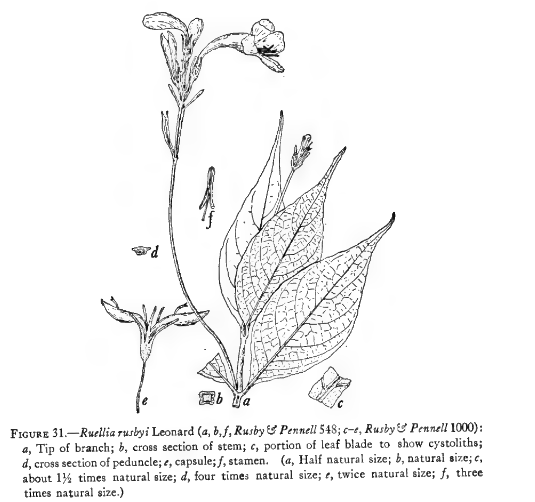
|
Family: Acanthaceae
|
Suffrutescent herbs; stems quadrangular (the angles rounded), glabrous or bearing a few small hairs at or near the nodes; leaf blades oblong-elliptic, up to 15 cm. long and 6 cm. wide, acuminate at tip, narrowed at base, rather thin, drying dark olive or blackish, glabrous, the costa and lateral veins (7 or 8 pairs) rather prominent, the cystoliths conspicuous under a lens, 0.25 mm. long, straight or nearly so; petioles 0.5 to 10 cm. long, glabrous; flowers borne in axillary peduncled cymes, the peduncles 10 to 12 cm. long, straight or slightly curved, flattened toward base, quadrangular toward tip, glabrous, once to twice branched at tip, both branches and flowers produced at the nodes, the secondary peduncles up to 12 mm. long, quadrangular, glabrous, the lowest node subtended by a pair of linear leaflike bracts 8 to 12 mm. long and 4 mm. wide, their margins un- dulate, the bracts subtending the secondary peduncles linear, about 4 mm. long and 1 mm. wide, glabrous; pedicels (mature) slender, 12 mm. long, glabrous; calyx 10 mm. long, glabrous, the cystoliths numerous and prominent under a lens, the segments linear, 8 mm. long, 1 mm, wide at base, obtusish at tip; corolla pink or red; capsule clavate, glabrous, 2 cm. long, 8-seeded, the seed-bearing portion 4 mm. broad at middle, the narrowed solid basal portion about 10 mm. long, 1.5 mm. wide at base and 2.5 mm. wide at base of cavity; seeds (immature) cordate, flat, about 3 mm. in diameter, gelatinous- puberulous when moistened; retinacula linear, 2.5 mm. long, the tip truncate and lacerate. Type in the Gray Herbarium, collected in forest east of Neiva, De- partment of Huila, Colombia, 1,300 to 1,800 meters altitude, August 1 to 8, 1917, by H. H. Rusby & F. W. Pennell (No. 1000). A fragment of the type is in the U. S. National Herbarium, No. 1933917; an isotype is in the herbarium of the New York Botanical Garden. Rusby and Pennell's No. 510 (NY), collected east of Neiva, 700 to 1,500 meters altitude, and No. 548 (NY), collected in the same general region, 1,200 to 1,700 meters altitude, also represent the species. Ruellia rusbyi is related to R. caucensis. In their general appear- ance and in the type of inflorescence the two species are very similar; yet there exist several differences by which they can be readily sepa- rated. The calyx of R. caucensis is smaller (5 mm. long instead of 10 mm. as in R. rusbyi), the channels of its petioles are definitely pubescent, and the leaf blades are shallowly dentate instead of un- dulate or entire, drying to a lighter olive-green. |


